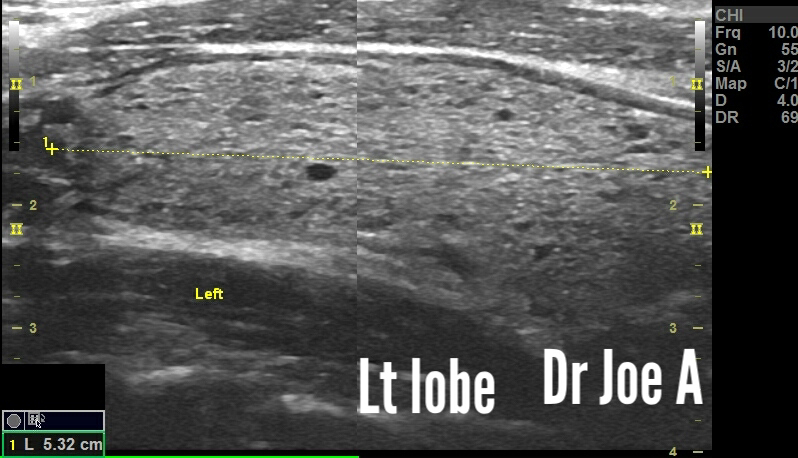Ultrasound images show a characteristic leopard 🐆 skin appearance of the thyroid with mild increase in flow on power Doppler ultrasound.
The leopard skin appearance of the thyroid gland on ultrasound is a characteristic finding of Hashimoto's thyroiditis, an autoimmune disorder that causes inflammation and enlargement of the thyroid gland. The ultrasound appearance is due to the presence of multiple, small, hypoechoic foci (areas of decreased sound transmission) within the thyroid gland. These foci represent areas of lymphocytic infiltration, or the accumulation of white blood cells (lymphocytes) in the thyroid tissue.
Other differential diagnoses for the leopard skin appearance of the thyroid gland on ultrasound include:
1. Graves' disease: An autoimmune disorder that causes hyperthyroidism, or overactive thyroid function. Not likely here as symptoms are not present. Also color Doppler shows normal vascularity.
2. Thyroiditis: Inflammation of the thyroid gland. Most likely, Hashimoto's thyroiditis in this case.
3.Thyroid cancer: A malignant tumor of the thyroid gland. Not likely here.
The ultrasound appearance of lymphocytic infiltration of the thyroid gland is variable and may not be specific for any particular disorder. In general, lymphocytic infiltration can cause the thyroid gland to appear enlarged, heterogeneous, and hypoechoic. However, the ultrasound appearance of lymphocytic infiltration may be normal in some cases.
Additional information about Hashimoto's thyroiditis:
1. Hashimoto's thyroiditis is the most common cause of hypothyroidism, or underactive thyroid function.
2 . The symptoms of Hashimoto's thyroiditis can vary from person to person and may include fatigue, weight gain, cold intolerance, dry skin, and hair loss.
3. Hashimoto's thyroiditis is treated with thyroid hormone replacement therapy.
The management and prognosis of lymphocytic infiltration of the thyroid gland depends on the underlying cause of the condition:
In the case of Hashimoto's thyroiditis, the condition is typically managed with thyroid hormone replacement therapy. This therapy helps to replace the thyroid hormone that is not being produced by the thyroid gland. With treatment, most people with Hashimoto's thyroiditis are able to live normal, healthy lives.
In some cases, lymphocytic infiltration of the thyroid gland may be a sign of thyroid cancer. If carcinoma thyroid is suspected, a biopsy of the thyroid gland will be performed to confirm the diagnosis.
Important information about lymphocytic infiltration of the thyroid gland:
A. Lymphocytic infiltration of the thyroid gland is a common finding in people with Hashimoto's thyroiditis.
B. Lymphocytic infiltration of the thyroid gland may also be seen in people with thyroid cancer.
C.The presence of lymphocytic infiltration in the thyroid gland does not necessarily mean that there is a problem.
For more on this topic visit:







No comments:
Post a Comment